African cichlids are the best way to have a fish tank that attracts attention and starts conversations. Even if you aren’t quite ready for a super high-maintenance fish-keeping experience, you should definitely consider African cichlids.
African cichlids are some of the most vibrant and colorful freshwater fish you can find. This means that you get all the benefits of keeping gorgeous fish without the added difficulties of maintaining a saltwater tank.
So what do we need to know in order to care for these fascinating freshwater fish? From cichlid fish food to water conditions, this guide will dive deeply into caring for all the fish on this list.
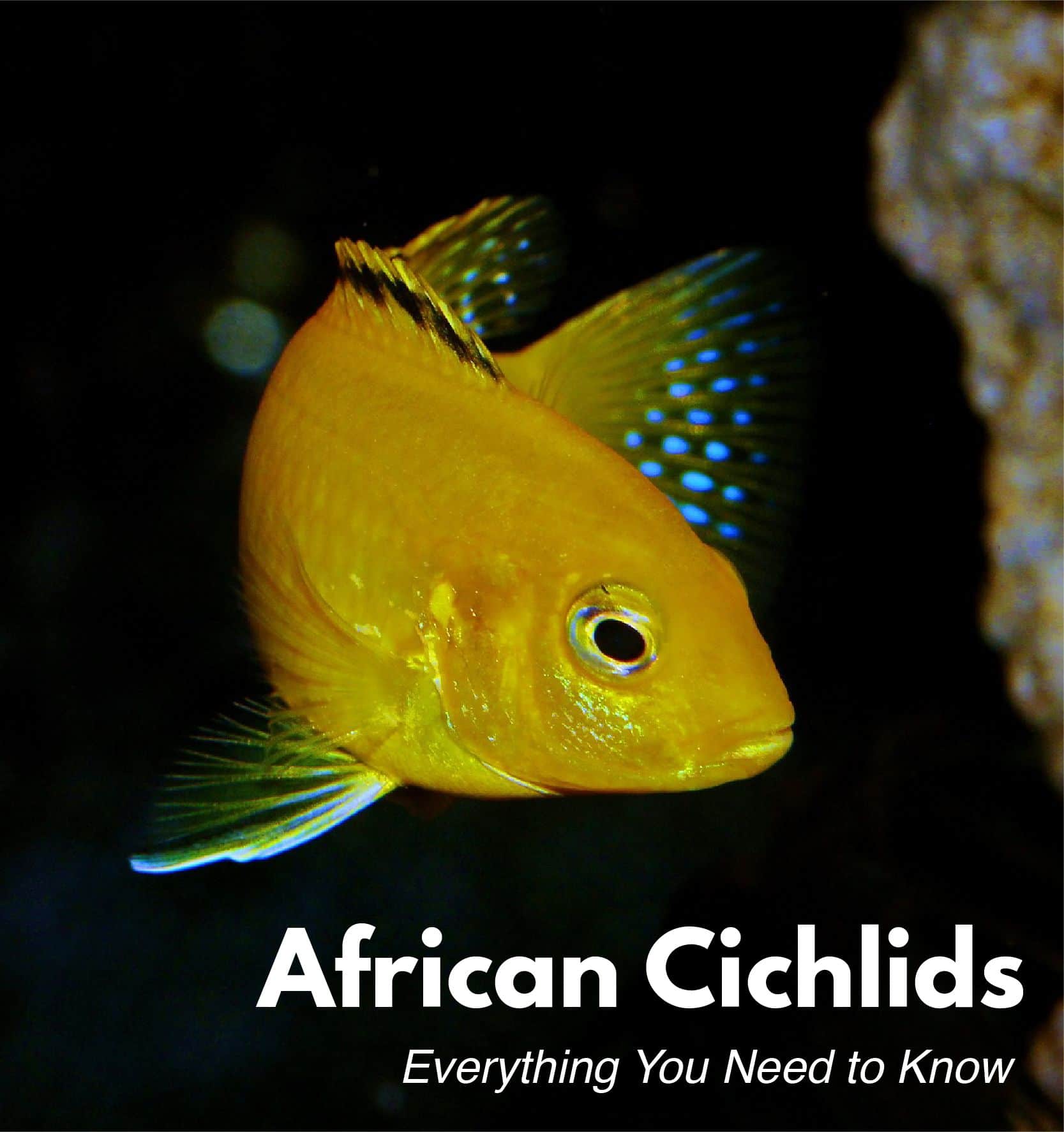
African Cichlids in the Wild
When people think of the different types of cichlids out there, they are often drawn to South American cichlids, which are very popular. But we will be focusing on Africa instead.
Africa is a very big place but the vast majority of African Cichlids are found in a few specific regions. There are West and Central African cichlids that live in rivers and streams throughout the area. Only a small number of these are common in the hobby – the Kribensis is the only one that makes our list of the most popular species.
And then there are the rift lake cichlids that come from Lake Malawi and Lake Tanganyika. And Lake Victoria, which is nearby but not a rift lake. Each of the lake African Cichlids is found in East Africa. And the majority are only found here – and only in their specific lake.
The rift lakes of East Africa are quite close to one another but don’t share water with each other. They are also extremely old; Lake Malawi is 1-2 million years old while Lake Tanganyika may be as old as 12 million years old.
Their ancient age and complete exclusion from other bodies of water mean that African cichlids have had a long time to diversify into many new species and niches. Their wild ancestors were all quite close to one another.
All of the fish in Lake Victoria, Lake Malawi, and Lake Tanganyika are Haplochromine fish and share common ancestors. But now they have become so different in form that few can interbreed with one another. The lakes of East Africa are a marvelous display of the power of evolution.
15 Popular African Cichlid Species
There are hundreds of cichlid species, though most of them are only found in the wild. The types described here are those most likely to be available for purchase as a pet.
Each type of African cichlid has its own unique combination of colors, patterns, and other physical traits.
It’s important to note that cichlids generally won’t display any of these distinctive colors until they are around one year old.
Hap Cichlids? Mbuna Cichlids? What Does It Mean?
You’ll probably see both of these terms used as you shop for and read about African cichlids. Unscientifically speaking, most of the African cichlids you’ll find are considered to be either Hap or Mbuna, which are both endemic to Lake Malawi.
Lake Malawi is home to more cichlid species than any other body of water in the entire world!
Without getting too deep into the very dry and boring taxonomic history of it all, Hap is short for Haplochromis, a genus of Lake Malawi cichlid.
Over the years, many fish once classified under this genus have been reassigned to other newly established genera. However, most are still commonly known as Haps.
Mbuna, to put it very simply, is the common term for the other main group of Lake Malawi cichlids.
The main differences between Hap and Mbuna cichlids are:
- Haps swim in open water, Mbunas prefer to dwell among rocks.
- While both are decidedly aggressive fish, Mbunas tend to be more so.
- Female Haps are usually less colorful than male Haps, whereas both sexes of Mbunas usually display bright colors.
- In the wild, Haps prefer to hunt and eat small fish. Mbunas are usually strict herbivores.
African Peacock Cichlids
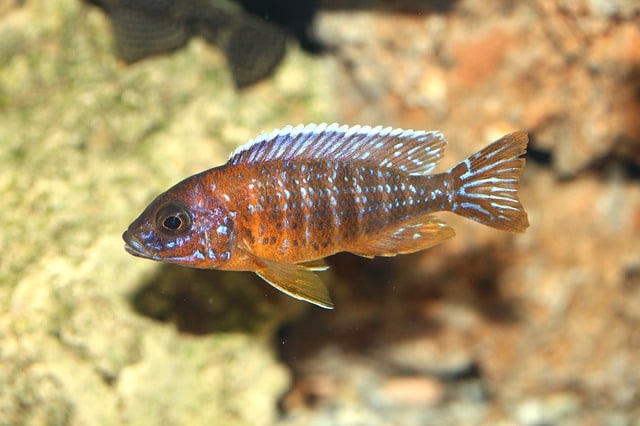
Peacock Cichlids are sought after for the brilliant colors they display. These cichlids are often less aggressive than some of their cousins, but still more so than many other species of fish.
Peacock cichlids hang out around the bottom of the aquarium. Mbuna are rock dwellers that eat algae. But in the wild, peacock cichlids hunt for food in the wide-open expanses of sand beyond the rocks. There are many different kinds of peacock cichlids, with names such as Midnight, Red Shoulder, Fairy, and lots more.
African Butterfly
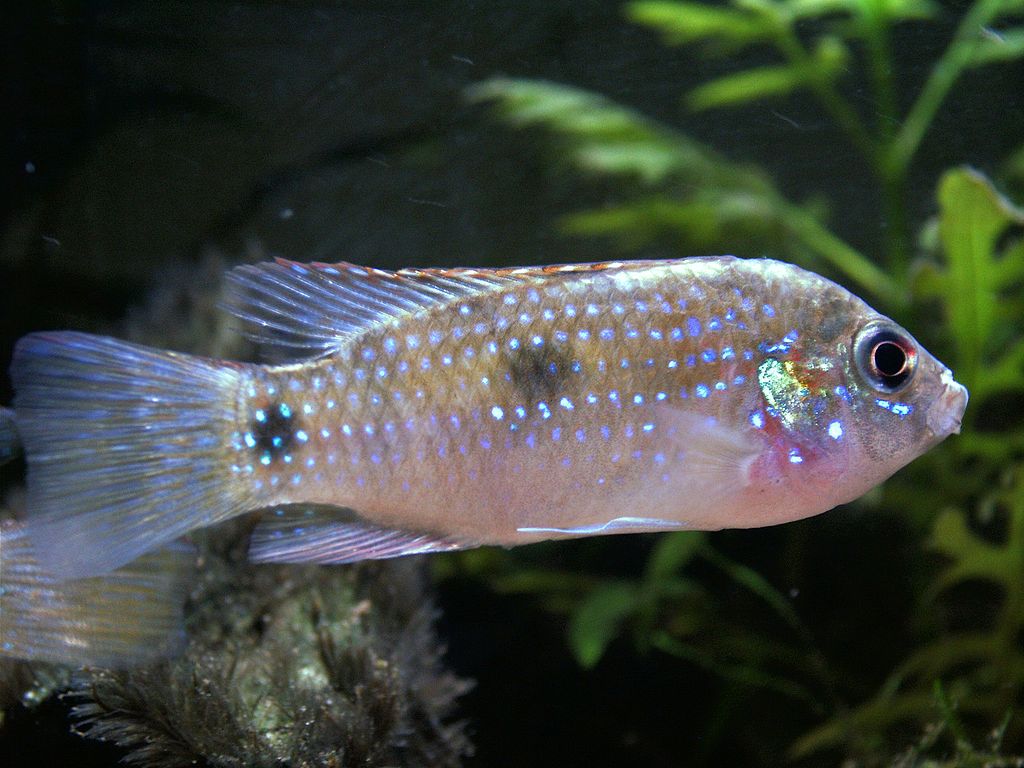
The African Butterfly cichlid is distinguished by the five black stripes running vertically along its body. They are relatively easy to care for (compared to other cichlids) and have a somewhat docile personality.
There are many reports of them getting along with many types of other fish, which is rare for cichlids.
Orange Zebra
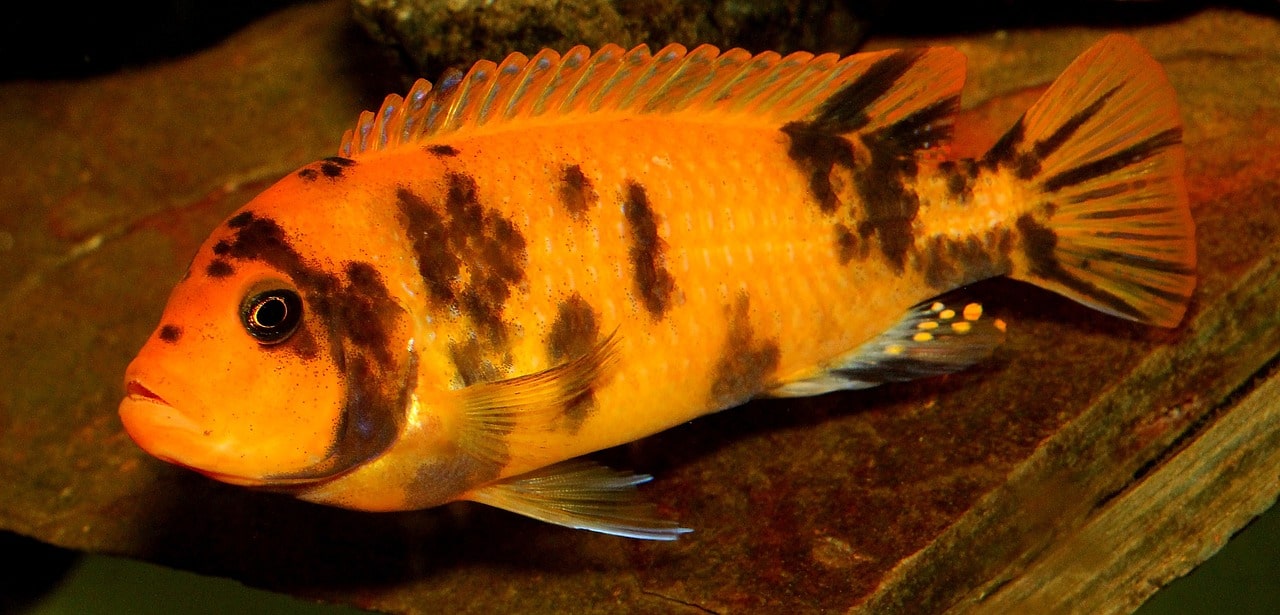
The Orange Zebra cichlid’s name comes from its markings: black stripes (or sometimes blotches) set against an orange-colored body. Their heads are rounded, and some display black-tipped fins.
They typically grow to about 5 inches long. This is a particularly aggressive variety of African cichlid, so take precautions when placing it in a tank with other fish.
Sometimes you will see similar colors in Peacock Cichlids. These are hybrids of Peacock cichlids and Mbuna and are known as O.B. Peacock Cichlids.
Zebra Cichlids
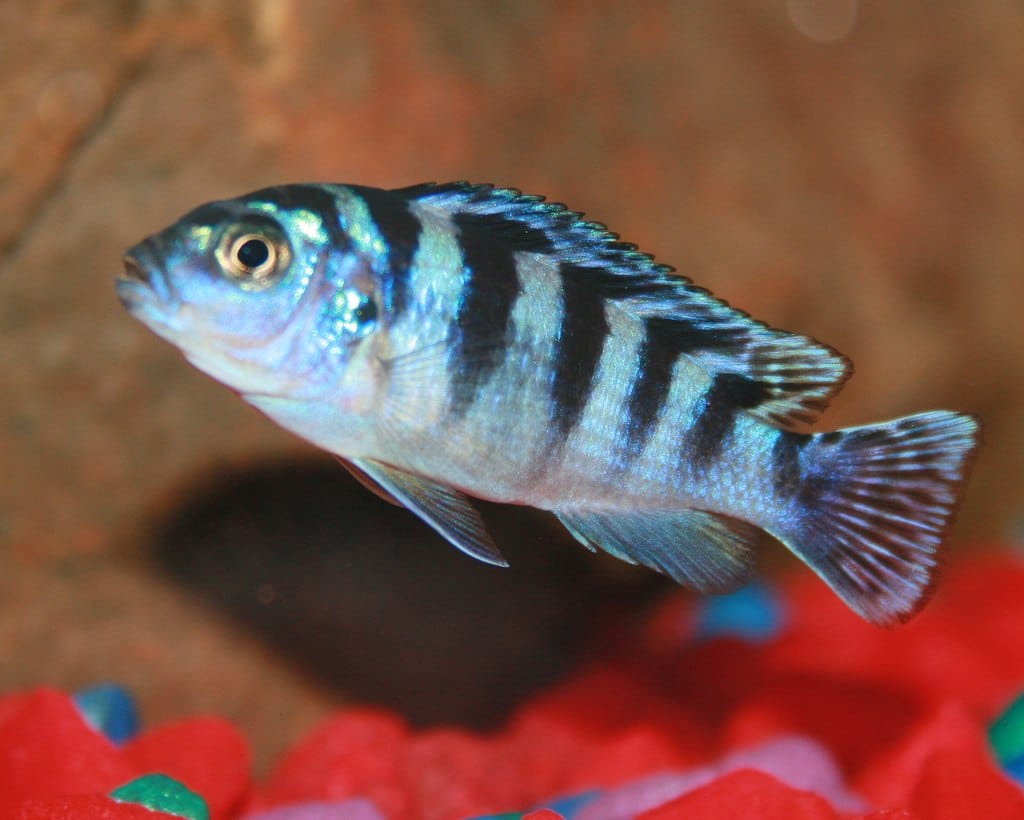
The Convict Cichlid is from Central America rather than Africa. As one would imagine, this fish has distinct black and white stripes on its body.
Electric Blue Hap
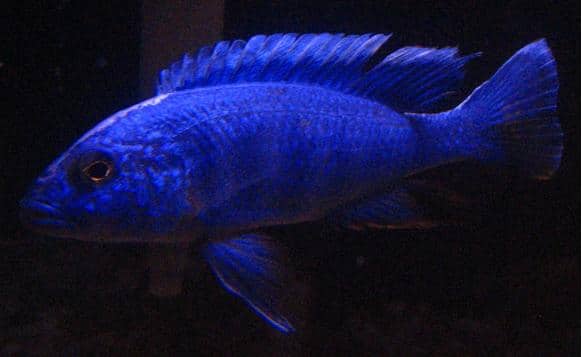
Suitable for new cichlid-keepers, the Electric Blue is relatively easy to care for and can sometimes cohabitate with other cichlids. A word of warning: don’t place your Electric Blue in the same tank as Peacock cichlids with the same colors.
They are too similar in color and form. So this almost always results in territorialism and fighting, particularly between males.
Electric Yellow
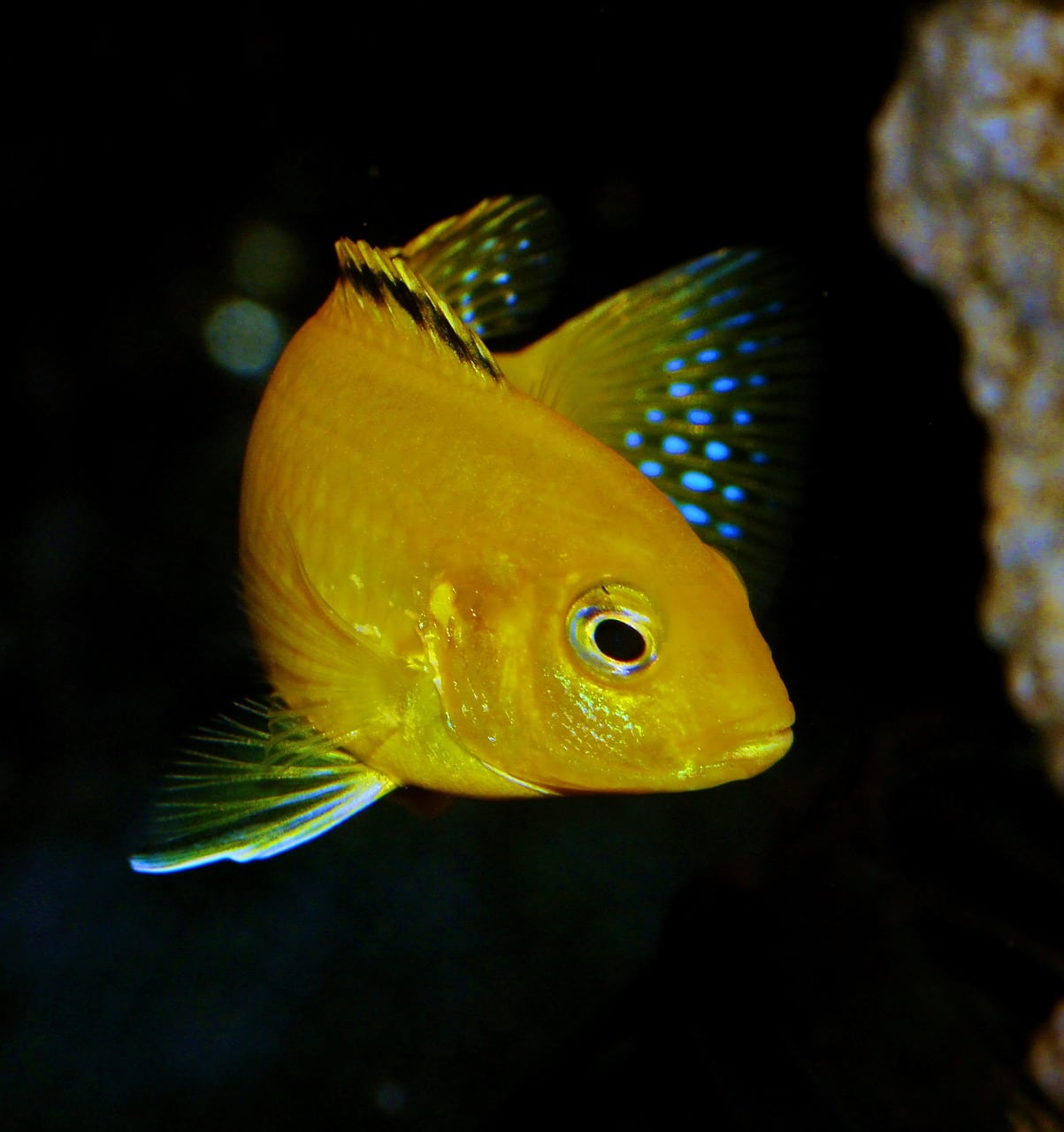
Another good choice for less experienced fish hobbyists, the Electric Yellow cichlid is small (usually about 3 inches).They are also somewhat less aggressive than many other types of African cichlids.
The distinguishing feature of the Electric Yellow is its bright yellow coloring, accented by stark black on the tips of its fins. It also has a notably long dorsal fin, which runs the entirety of its body.
Other names these African cichlids go by include Yellow Lab and Lemon Drop.
Buffalo Head
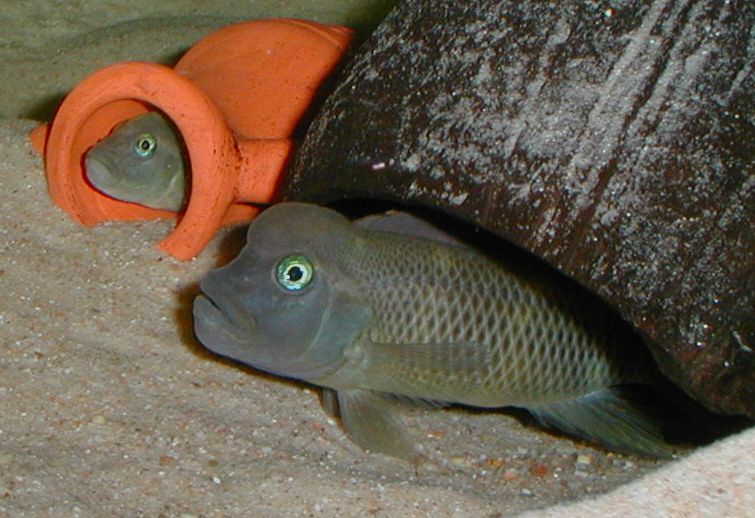
The African Buffalo Head cichlid goes by many names. A few of them are Humphead, Lionhead, and Blockhead.
These descriptive monikers all come from this fish’s unique appearance; it has a very prominent forehead. These African cichlids are fairly easy to keep for the beginner-level enthusiast.
They grow to be around 4 ½ inches or so and are relatively peaceful when compared with some of their cichlid contemporaries.
Blue Dolphin Moorii
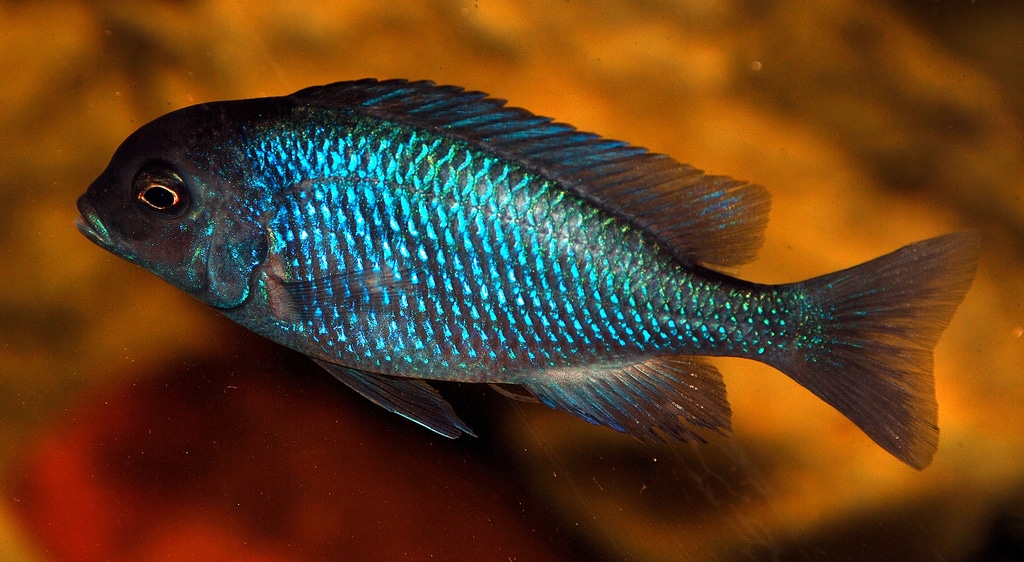
The Blue Dolphin Moorii is a hit in aquariums because of its striking beauty and pronounced forehead. Something else that makes these African Cichlids especially impressive is their size.
Many grow to be 9 to 10 inches or longer. That said, Blue Dolphins are usually not considered the best pick for beginners. They require a large tank and are rather high-maintenance pets.
Maingano
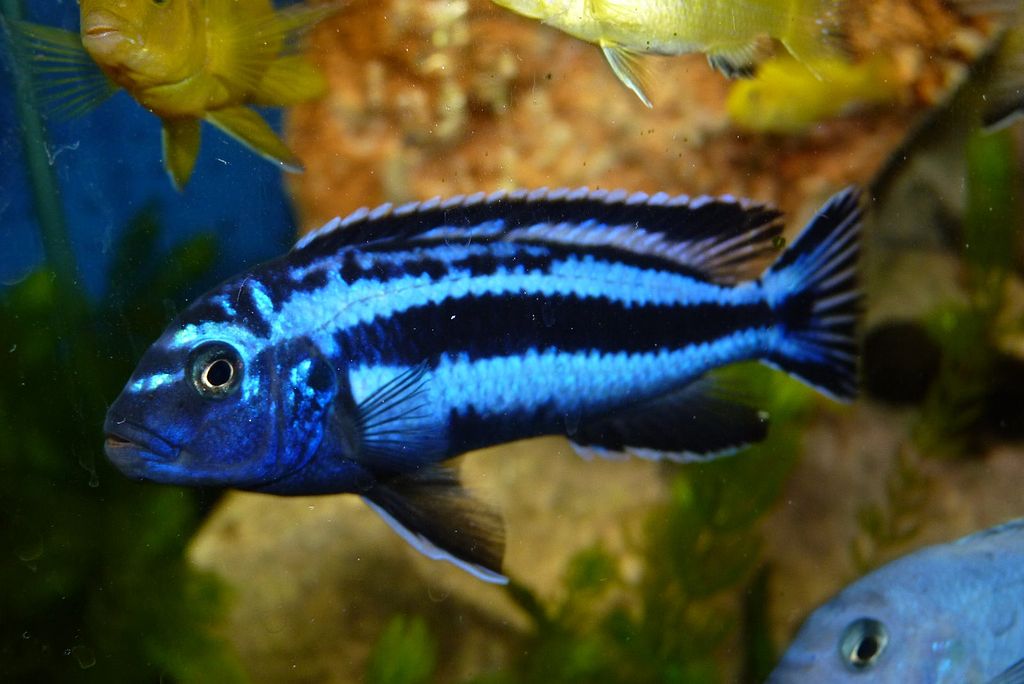
The Maingano is a Mbuna that comes from a very limited portion of Lake Malawi.
It is highly attractive, displaying bright blue horizontal striping along with a sleek and streamlined body shape. These small cichlids are sometimes mistaken for Electric Blues.
Compressiceps
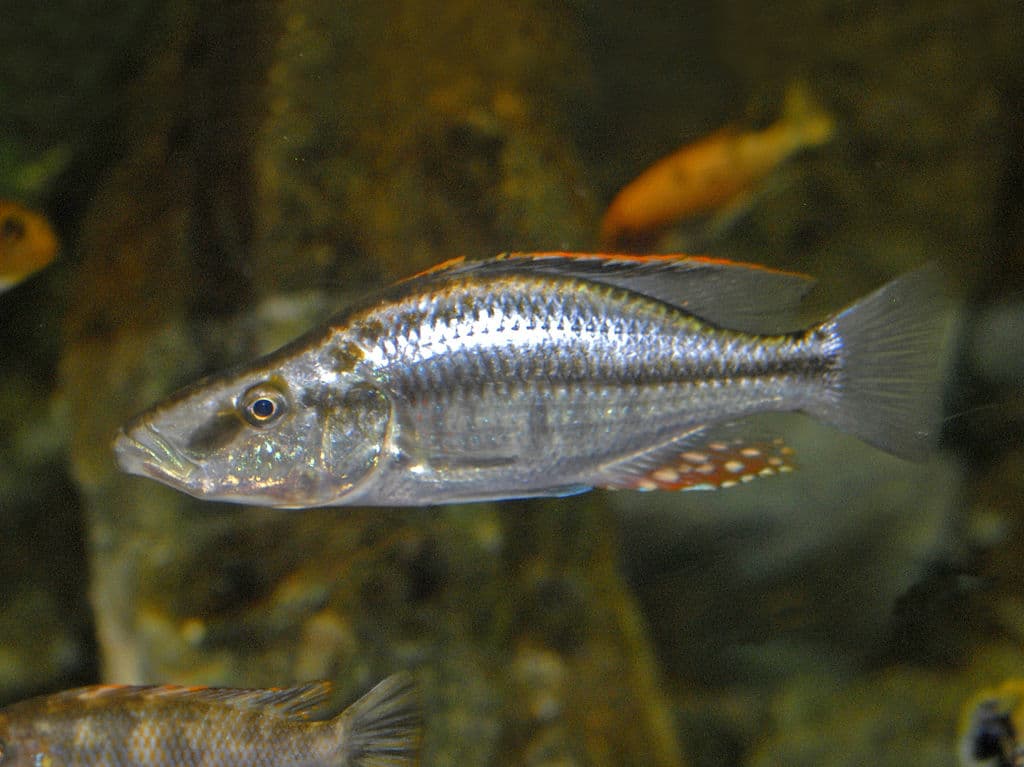
Long and slender, this fish usually displays a shimmering silver color that looks lovely in any aquarium. These fish are large, with males growing 9 inches or longer.
They are also aggressive, so you need to give them plenty of tank space and take care when housing them in a community habitat.
Kribensis
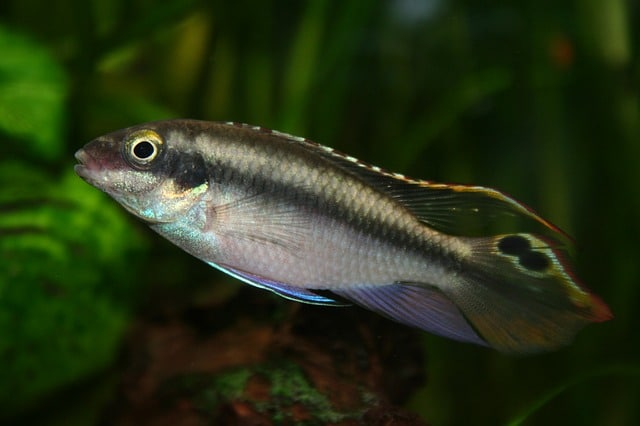
The Kribensis is a dwarf cichlid that is found in West and Central Africa. It is small and on the less aggressive side. Because of this, it’s considered a good pet for people just starting out with cichlid-keeping.
Sometimes called by its shortened name “Kribs,” this small cichlid grows to no more than 3 or 4 inches upon maturity.
Just remember that like any cichlid even Kribs become fairly aggressive when defending their eggs and fry when breeding. So if you have a male and female make sure their tank is spacious when kept with other fish.
Giraffe Cichlid
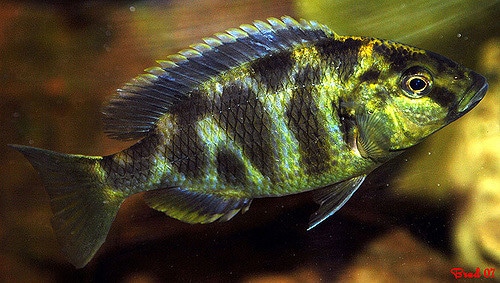
The Giraffe Cichlid, also known as the Venustus, has a bold blue face that stands out against its patterned body. This variety of cichlid needs lots of space since it can grow to be 10 inches or longer.
The Giraffe is a more intermediate-level fish since it is known to be very sensitive to water conditions (particularly nitrite levels).
Sunshine Peacock
The Sunshine Peacock adds a pop of color to the aquarium. Yellow with contrasting blue markings, these fish would sit somewhere in the middle of the cichlid aggression scale.
They’re also fairly hardy African cichlids, often tolerating moderate changes in water conditions.
Frontosa Cichlid
Moving onto Lake Tanganyika, the Frontosa cichlid is a popular tropical fish species well worth considering. These are one of the largest commonly available African cichlids; males can grow just over a foot in length.
Frontosas are deep water predators that ambush smaller fish from below. However, you can offer them fresh protein of any kind, including chopped shrimp, mussels, fish slices, and so on.
Being residents of Lake Tanganyika Frontosas do prefer even harder and more alkaline water than Lake Malawi cichlids. Aim for a pH closer to 9.0 for these rift lake cichlids.
Fairy Cichlid
The Fairy Cichlid is likely tied with the Frontosa as the most popular of the Lake Tanganyika tropical fish to find in stores. These are much smaller African cichlids, growing no larger than 5 to 6 inches in length.
Males have beautiful white fin extensions and both sexes are a pale peach to light purple color. They also do very well when kept in groups of around 6 individuals and are one of the easier cichlids to spawn in captivity.
And like the Frontosa the Fairy Cichlid also prefer the harder water conditions of Lake Tanganyika (pH 8.5-9.0). Any lower and their health will likely suffer.
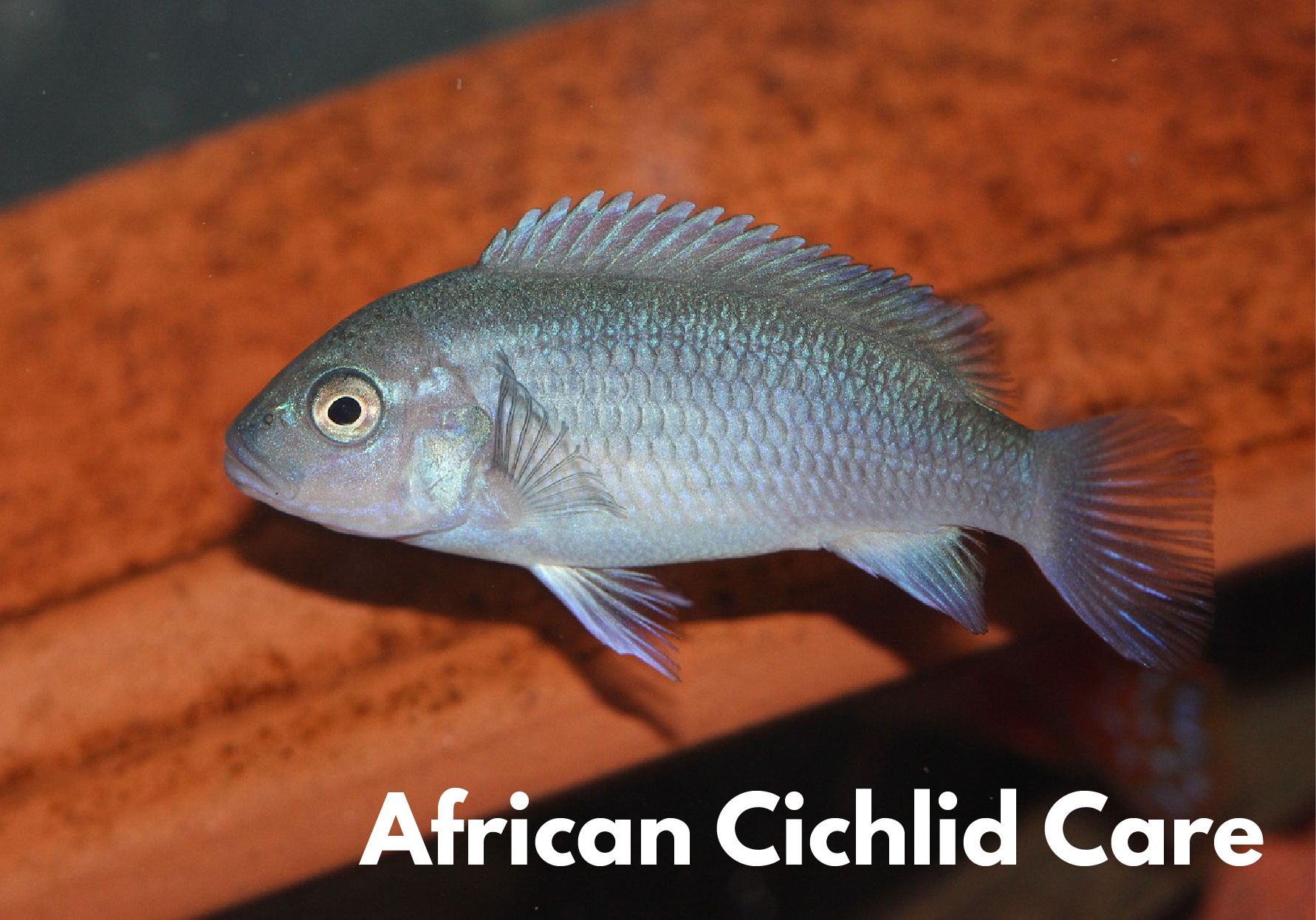
Caring for African Cichlids
When you decide to populate your tank with African cichlids, know that you’re making a commitment to take good care of your new pets. Invest in the right equipment to keep your aquarium clean and safe.
Learn as much as you can about the day-to-day needs of these fascinating pets, and make it a priority to maintain their habitat properly. Your fish will be happier, healthier, and more enjoyable to observe as a result.
African Cichlid Fish Food
Different varieties of African cichlids have different dietary preferences in the wild, but most captive cichlids are omnivorous and can adapt to a diverse diet.
Generally speaking, it’s best to feed them a variety of fish foods. Most enjoy cichlid pellets and wafers, as well as frozen tubifex worms and brine shrimp. Cichlids should be fed twice a day.
Give them no more fish food than they can consume in 2-3 minutes, or you’ll risk overfeeding them. (Overfeeding can create more waste than your filter can handle, and you’ll have to change the water often or risk unhealthy and potentially deadly conditions in the tank).
Habitat
Before bringing your African cichlids home, you must have a suitable aquarium to place them in.
You’ll need one that is of quality construction, with a watertight seal. Ensure that it has been cleaned and sanitized before you set it up for your fish.
Tank size
Smaller African cichlids need a 20-gallon tank, at minimum. Give larger ones (6 inches or above) at least a 30-gallon tank. If you’ll be keeping a community aquarium, accommodate for the number and size of fish that will live there.
The general formula is that you will need roughly 2 gallons of water per inch for each additional fish housed in the tank. Remember to base your calculations on mature fish sizes, since juveniles will inevitably get bigger.
Temperature
Most aquariums for African cichlids should be kept between 72 – 82 degrees Fahrenheit. Use a thermometer to ensure that the temperature stays within a healthy range. You can use an aquarium heater to keep the water warm enough; be sure the heater is sufficient to heat the size of the tank you have.
I always recommend the Cobalt Aquatics Neotherm – it is the best heater on the market (in my opinion).
Larger aquariums, particularly those kept in cooler locations, may require more than one heater to maintain the right temperature.
Filtration
Like any fish, cichlids create waste that can build up and become toxic. So, you’ll need to have a good filtration system for your cichlid tank.
Use one that is on the higher end of what is acceptable for your tank size; cichlids happen to produce even more waste than your average aquatic creature.
There are so many aquarium filters available. Ultimately, you must select a quality filter that is suitable for the size and population of the tank.
When choosing a filter, it’s important to understand a bit more about them.
There are 3 types of filtration:
- Biological: Biological filtration is the use of biological media to grow populations of specific bacteria that serve to digest and convert aquatic toxins.
- Mechanical: Mechanical filtration collects aquarium debris by physically filtering it out of the water.
- Chemical: Chemical filtration involves the use of chemical media, such as carbon or ferric oxide, to remove unwanted elements from the water.
There are a lot of different types of filters on the market. The following list includes the most popular and commonly used.
- HOB (Hang On Back): As indicated by the name, a hang-on back filter hangs on the back of your aquarium. This is a really popular choice across the board for fish hobbyists because it provides all 3 types of filtration and doesn’t take up a lot of space in the tank.
- Canister: Canister filters also provide mechanical, biological, and chemical filtration. They are usually rather large, and a bit more expensive than HOB filters. However, many cichlid owners prefer them because they are able to provide powerful filtration for large-capacity tanks.
- Internal: These filters hang inside the tank, taking up very little space. While they do perform all 3 types of filtration, they are usually not ideal for tanks over 20 gallons.
- Undergravel: As the name implies, these filters are installed underneath gravel substrate. While certainly useful, they may fall short in providing adequate filtration for a cichlid tank since they only allow for mechanical filtration. This is why these are often used in conjunction with other types of filters.
Aquarium Fish Lighting
Cichlids do not require any special lighting to stay healthy, though you’ll probably want to install an aquarium light so you can enjoy watching them. You can use fluorescent or LED lighting.
Note that fluorescent lights can increase water temperature, so keep this in mind when shopping for lighting. A lot of hobbyists prefer to use LED lights simply because they illuminate the beautiful colors of their cichlids more brightly.
Water Conditions
Unlike West African and South American cichlids that prefer softer chemistry, African cichlids prefer hard, alkaline water conditions. This means we want a pH that is above neutral. A pH range of 7.5-8.5 is perfect for them, depending on which lake they are from.
Lake Tanganyika has harder, more mineral-rich water than Lake Malawi. Fortunately, you can buy mineral salt blends that are formulated to match both Lake Malawi and Lake Tanganyika.
These conditions are not great for most aquarium plants, which prefer less mineralization. A few species of aquarium plants will survive alongside African cichlids though, including Vallisneria (eelgrass) and Java Fern.
Choosing the Right Substrate
Many African cichlids love to dig around in their substrate in search of food; peacock cichlids most of all. Choose a substrate that allows them to do this. Sand, crushed coral, and small pebbles are all ideal flooring materials for an African cichlid habitat.
Crushed coral gravel or sand is especially helpful in maintaining a high pH. Coral skeletons are made from calcium carbonate, which buffers the pH towards alkalinity. But if you are using tap water plus a Lake Malawi or Lake Tanganyika mineral salt blend then you should have no problems maintaining a high pH in your aquarium.
Rocks, Plants, and Other Décor Items
African cichlids live in areas that are full of rocks and boulders. Cichlids are happier and healthier when they have secret areas to explore and hide behind. Rocks also leach minerals into the water, keeping the pH high for your freshwater fish.
You can use rocks, plants, or pre-made tank furniture to create this in your aquarium. In a community tank, these hiding places are absolutely necessary to help prevent fighting over dominance and territory.
When placing rocks in your aquarium, make sure they are secure and won’t tip over on your fish. You can use a special waterproof glue to create rock features in the tank, just make sure it’s a formula made to be non-toxic to aquatic life.
A Few More African Cichlid Care Tips
Don’t be afraid to reach out to the experts with questions as you go. Online aquarium forums and fellow hobbyists can be excellent resources, and you can always call your local pet store for advice. Keep reading for some helpful information on being a good, upstanding cichlid-keeper.
1. Always place your aquarium on a stable, strong surface. Use a tank that is in good repair and does not leak water. Ensure that you have a well-secured lid, as some acrobatic cichlids can jump out of an open tank.
2. It’s very important to properly “cycle” a new tank before introducing aquatic life. There are a couple of ways you can do this. Decide on your method and prepare all the supplies you’ll need in advance.
3. Wash your hands thoroughly after cleaning your tank. Sanitize any sinks or other surfaces where tank elements are handled. Don’t clean your fish tank on food prep surfaces, either. Take extra care if you include children in caring for the cichlid tank. Teach them that it’s important to wash their hands before and after handling anything from the aquarium.
4. Keep an eye on your fish. Watch for signs that something isn’t right. The following symptoms could indicate serious problems. If you see any of them, consult a veterinarian.
- Aversion to food, loss of appetite.
- Swollen abdomen
- Swelling elsewhere on the body
- Discoloration and/or dullness in fish that were previously colorful.
- Abnormal behavior or swimming patterns
- Lethargy
Watch out for potential issues in your aquarium, and also when you’re out shopping for new fish. Always purchase fish raised in a healthy environment. Don’t bring home a fish that has been housed with sick fish.
Be sure to follow any specific care instructions from your breeder or local pet store when you purchase a new fish. These should always supersede any general guidelines.
Tank Mates for African Cichlids
Take care when selecting tank mates if you decide to create a community habitat. First and foremost, make sure there’s plenty of room in the aquarium for your cichlid to have its own space.
Fish that will be sharing the waters with a cichlid stand a good chance of being accosted. Aggressive fish will fight back, which could result in injury (or worse) for both fish. Small fish will probably become that day’s lunch.
Bottom-feeding fish can make good neighbors for African cichlids. Stick to varieties that are similar in size and temperament. Many people have had success in keeping African catfish with various cichlid varieties. The two should mostly keep to themselves since they occupy different parts of the tank. However, it’s always possible that the aggressive fish will try to attack one another.
It’s best to put multiple types of fish together when all are juveniles. Introducing a new fish to an established cichlid tank is likely to result in injury (or worse).
It’s never a good idea to place South American cichlids with African cichlids, as their needs are different.
The bottom line is that it’s always risky to place any other type of fish with your African cichlids. Do so only with guidance from a trusted breeder or pet store.
African Cichlids: Conclusion
Of all the freshwater fish out there, African cichlids are some of the most satisfying to keep. South American cichlids often get far more attention but there is a lot to discover in Africa. From the peacock cichlids of Lake Malawi to the Frontosas of Lake Tanganyika, African cichlids are active, personable, and come in a staggering array of colors.
They aren’t especially hard to keep, accept most fish food, and will likely breed for you as well. Hopefully, this care guide has made it easier to get a tank of these fish up and running.
More Frequently Asked Questions about African Cichlids
Still not finished learning about this fascinating group of fish? Then here is a little more on all the fish in this guide.
How Many African Cichlids Should be Kept Together?
The exact number of African cichlids depends a lot on the species you are keeping. Some are solitary while others prefer being kept in groups. Generally, it is safe to keep several species together since these fish often live in close proximity to each other, especially the rock-dwelling mbuna.
What Fish Can Live with African Cichlids?
It can be hard to find fish that can live with African cichlids because they live in fairly extreme water conditions and are pretty aggressive. Choose dither fish that tolerate hard, alkaline water and are fast-moving. These include rainbowfish, danios, and many barbs. Livebearers also enjoy hard water but many of the smaller species are able to be eaten. Mollies are an exception, though.
Are African Cichlids Hard to Keep?
Most African cichlids are not too difficult to keep. The main trouble is in managing their need for hard water and their aggressive tendencies. Once you’ve solved these issues these fish are hardy, long-lived, and tend to be easy to breed.
How Many African Cichlids Can be in a Tank?
If you are keeping mbuna with other African cichlids then crowding them a little is actually a good idea. They live in tight groups in nature and thrive in each other’s company. But with other species, you will need to be more careful about crowding as aggressive spats can result.

